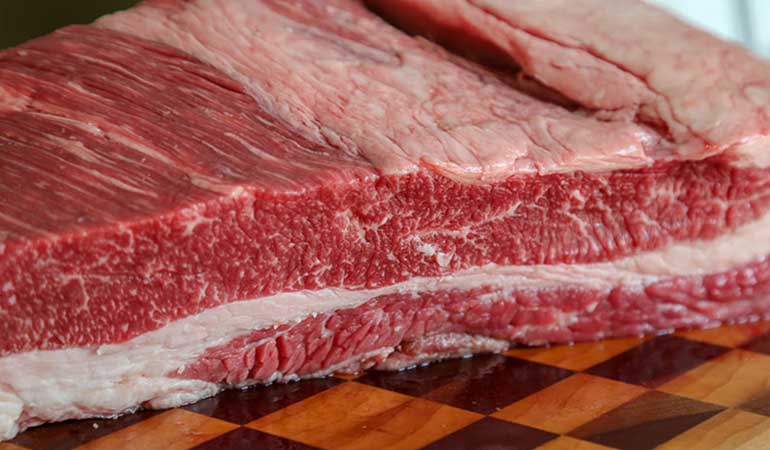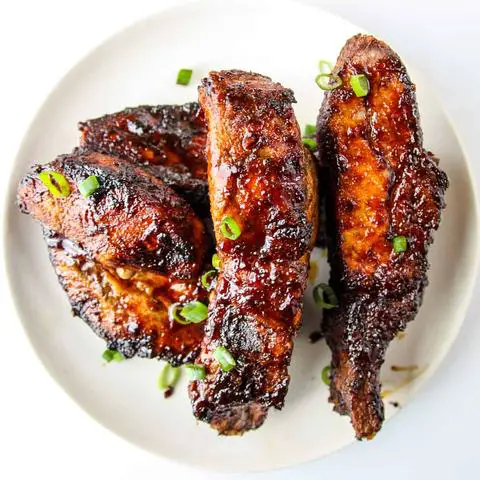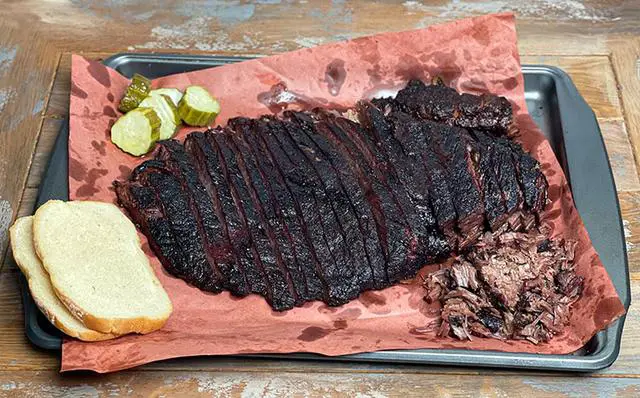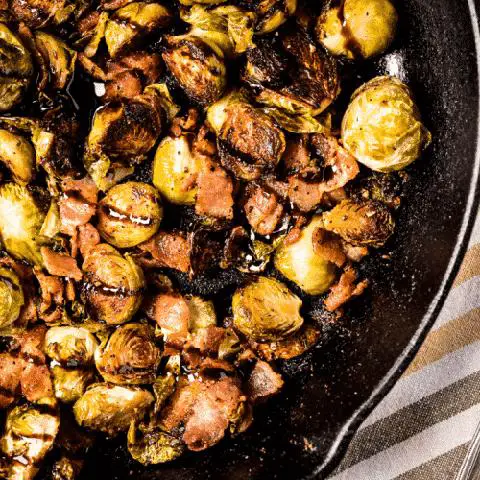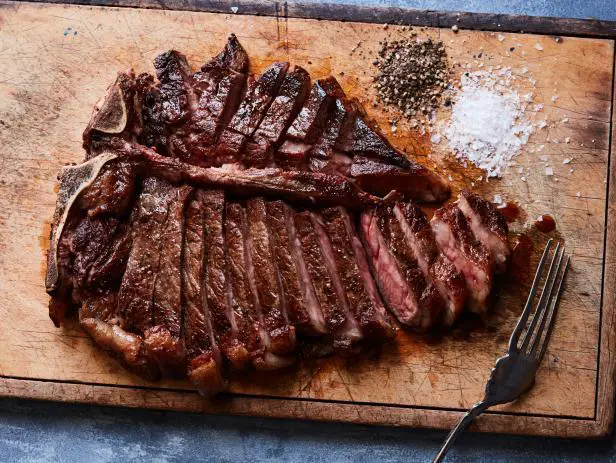
“Master the Art of Pan-Frying T-Bone Steak: Unleash your culinary prowess with this easy-to-follow guide on achieving perfection when pan-frying succulent T-bone steak. Learn the expert tips and techniques to sear a tender, juicy steak that is bursting with flavor. Elevate your cooking skills and impress your guests with this mouthwatering classic dish.”
Pan Seared T-bone Steak: Easy, Simple Recipe

The T-bone steak is a flavorful and impressive cut of meat that consists of a central “T-bone” and two muscles – the tenderloin and the NY strip. To enhance the flavor and texture of your pan seared T-bone steak, there are a few simple steps you can take.
First, when selecting your T-bone steak, opt for one that is USDA choice graded or higher. This ensures that the meat has a high amount of intramuscular fat, which adds to its tenderness and flavor. However, most T-bones will also have a strap of back fat attached. This fat is hard and does not fully render during cooking, leaving an undesirable gristle on each slice. Consider trimming some of this back fat before pan searing for a better eating experience.
Dry brining your steak overnight in the refrigerator is another technique that can greatly improve its taste and texture. Dry brining involves coating the steak with kosher salt, which helps tenderize the meat by disrupting its protein structure and enhancing its water-holding capacity.
What to Look for in T-bone Steak
When selecting a T-bone steak, there are a few key factors to consider. Firstly, look for steaks that are USDA choice graded or higher. This indicates that the meat has a high amount of intramuscular fat, known as marbling, which enhances the flavor and tenderness of the steak.
In addition, pay attention to the size of the tenderloin muscle in the T-bone steak. While most T-bones are similar, some may have a larger or smaller loin. Packs of three T-bone steaks often contain 1-2 with a decent loin and 1-2 with a smaller loin. Choose steaks with a thick backstrap and trim any excess back fat before cooking to ensure a better eating experience.
Lastly, consider dry brining your T-bone steak before cooking. Dry brining involves rubbing kosher salt onto the surface of the steak and allowing it to sit in the refrigerator overnight. This process tenderizes the meat and adds flavor by drawing out moisture and reabsorbing it along with the salt.
Trimming the Strap of Back Fat on the NY Strip Side

When preparing a pan-seared T-bone steak, it is important to trim the strap of back fat on the NY strip side. This fat, although common in T-bone and NY strip steaks, does not enhance the eating experience and can be tough and unpleasant. To remove this fat, simply trim off a small portion before cooking the steak.
While some argue that this fat adds flavor, it is hard and subcutaneous, meaning it won’t fully render during cooking. Leaving it untrimmed can result in gristle of fat on each slice. Additionally, many people slice this part of the steak incorrectly. Therefore, it is recommended to trim any thick backstraps before pan searing for a better eating experience.
Dry Brining the T-Bone Steak
Dry brining is a technique that involves using kosher salt to enhance the flavor and tenderness of the steak. To dry brine a T-bone steak, simply sprinkle kosher salt on all sides of the steak and place it on a cooling rack in the refrigerator overnight. The salt will penetrate the meat, tenderizing it and adding flavor.
One issue with T-bone steaks is that they often come with a strap of back fat. This fat is hard and not palatable, so it’s recommended to trim some of it before cooking. Simply remove any excess fat from the strip loin side of the steak, leaving only a thin layer for flavor.
To achieve a perfectly seared T-bone steak, it’s important to use a high smoke point oil like grapeseed oil and heat your skillet over medium-high heat. Once hot, add your cold oil and wait for it to shimmer before placing the steak in the pan. Flip the steak every 30-90 seconds until it reaches 10°F below your desired internal temperature. Then, remove from heat and butter-baste to further enhance the crust. Resting the steak for about 1 minute before slicing is optional but not necessary for retaining juiciness.
Using a High Smoke Point Oil

When pan searing a T-bone steak, it is important to use a high smoke point oil. This type of oil conducts heat better than air and helps to prevent the steak from sticking to the skillet. Grapeseed oil is a great option as it has a relatively high smoke point, is neutral in taste, and affordable.
Cooking a T-bone steak in a cast iron skillet can result in uneven searing due to the bone causing the meat to lift from the cook surface. To avoid this, it is recommended to heat the skillet over medium-high heat until hot, rather than getting it as hot as possible. This allows for more even cooking and browning of the surface of the steak.
Dry brining involves using kosher salt to season the steak ahead of time, allowing it to absorb its own salty brine and tenderize through protein denaturation. Dry brining can be done overnight or for at least 1-2 hours before cooking. It helps to enhance flavor and improve water holding capacity within the muscle cells of the steak.
Getting Your Cook Surface Hot
To achieve a perfectly seared steak, it’s important to get your cook surface hot. However, contrary to popular belief, you don’t want to get your skillet “screaming” hot or as hot as possible. Instead, heat your skillet over medium-high heat until it is hot but not smoking. This will ensure even cooking and prevent the steak from charring and developing bitter flavors.
When pan searing a T-bone steak, it’s essential to use a high smoke point oil. This type of oil conducts heat better than air and helps in browning the surface of the steak. Grapeseed oil is an excellent choice for pan searing as it has a relatively high smoke point and is neutral in taste. You’ll want to use slightly more oil than you would for regular searing, but not enough for deep frying.
Before placing the T-bone steak on the hot skillet, make sure to pat dry all sides of the steak with paper towel. This step helps remove any excess moisture that can hinder the formation of a crust on the surface. You can then apply freshly cracked pepper directly on the steak before cooking. Some people prefer to add pepper after cooking, so feel free to adjust according to your personal preference.
Remember that achieving a perfect pan-seared T-bone steak requires attention to detail and proper technique. By following these steps, you’ll be on your way to creating a flavorful and beautifully seared T-bone steak at home.
How to Pan Sear/Fry T-Bone Steak
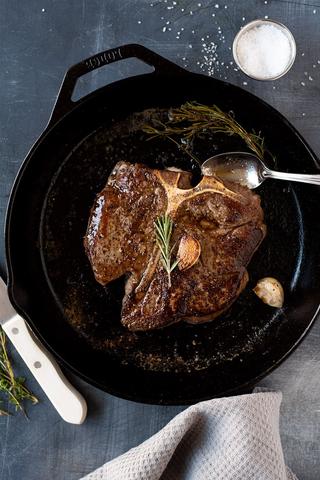
T-bone steak is a delicious and impressive cut of meat that can be easily cooked to perfection with the right techniques. To start, it is recommended to trim any excess back fat from the strip loin side of the steak. While some fat can add flavor, the back fat on T-bone steaks tends to be hard and not palatable. Trimming this fat will result in a better eating experience.
Before cooking, it is beneficial to dry brine the steak overnight in the refrigerator. Dry brining involves sprinkling kosher salt on all sides of the steak and allowing it to sit for 1-2 hours or overnight. This process helps tenderize the meat and enhances its flavor.
To achieve a perfectly seared crust, it is important to use a high smoke point oil such as grapeseed oil. Heat a cast iron skillet over medium/high heat and add enough oil to coat the bottom of the skillet. Once the oil starts shimmering, place the T-bone steak in the skillet and lightly press it down with tongs for even surface contact.
Pan Seared T-bone Steak
T-bone steak is a delicious and impressive cut of meat that can be easily prepared with a few simple steps. One way to improve the cooking process is by trimming the strap of back fat that is commonly found on T-bone steaks. This fat is hard and doesn’t fully render, leaving a gristle-like texture on each slice. By removing some of this fat before cooking, you can enhance the eating experience.
Before cooking the steak, it’s recommended to dry brine it overnight in the refrigerator. Dry brining involves applying kosher salt to the steak, which helps tenderize and flavor the meat. The salt draws out moisture from the muscle tissue and then gets reabsorbed, resulting in a more flavorful and tender steak.
When it comes to pan searing the T-bone steak, using a high smoke point oil like grapeseed oil is ideal. It conducts heat better than air and helps create a nice crust on the surface of the steak. It’s important not to heat the skillet too hot but rather at medium/high heat to ensure even browning without charring. Flip the steak every 30-90 seconds until it reaches your desired internal temperature.

Equipment
To make a pan seared T-bone steak, you will need the following equipment:
- A T-bone steak
- A sharp knife for trimming
- Kosher salt for dry brining
- Paper towels for patting dry the steak
- Freshly cracked pepper for seasoning
- A cast iron skillet for cooking
- Tongs for flipping the steak
- A spoon for butter basting
- A cutting board for resting and slicing the steak
Ingredients
– T-bone steak
– Kosher salt
– Freshly cracked black pepper
– High smoke point oil (such as grapeseed oil)
– Butter (approximately 2 tablespoons)
Instructions
1. Trim any excess back fat from the strip loin side of the T-bone steak. This fat is hard and does not enhance the flavor or texture of the meat.
2. Dry brine the steak by sprinkling kosher salt all over it and letting it sit in the refrigerator overnight. This process tenderizes the meat and adds flavor.
3. Before cooking, pat dry the steak with paper towels to remove any surface moisture.
4. Optional: season the steak with freshly cracked black pepper for added flavor.
5. Heat a cast iron skillet over medium-high heat and add a generous amount of high smoke point oil, such as grapeseed oil.
6. Once the oil shimmers and starts to smoke slightly, place the T-bone steak in the skillet away from you and lightly press down with tongs to ensure even contact with the pan.
7. Flip the steak after 30-90 seconds and continue flipping every few minutes until it reaches an internal temperature of 10°F below your desired doneness (e.g., 115°F for a target temperature of 125°F).
8. Remove the skillet from heat and place it on a different burner that is turned off.
9. Use a spoon to scoop frothed butter from one end of the skillet and baste it over the top of the steak for about 30 seconds per side using an “arouser method.”
10. Take the steak out of the skillet and let it stand on a cutting board for a minute or two before slicing.
Note: Resting time after cooking is optional, as it may not significantly impact juiciness according to personal preference.
In conclusion, pan frying a T-bone steak is a quick and delicious way to enjoy this classic cut of meat. By following a few simple steps, you can achieve a perfectly cooked steak with a flavorful crust. Whether you prefer it rare, medium, or well-done, pan frying allows you to tailor the cooking time to your preference. With its juicy tenderness and mouthwatering taste, pan fried T-bone steak is sure to satisfy any meat lover’s cravings.
Learn More About Grilling
If you want to learn more about grilling, check out these other helpful resources!

